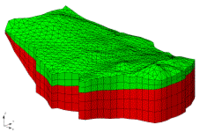GMS:FEMWATER Particle Sets
| FEMWATER | |
|---|---|
 | |
| Pre-processing | |
| Building a FEMWATER Model | |
| FEMWATER Model Input | |
| Saving a FEMWATER Simulation | |
| Post-processing | |
| FEMWATER Display Options | |
| FEMWATER Post-Processing Viewing Options | |
| Tutorials | |
| FEMWATER Tutorials | |
Particle tracking can be done with a FEMWATER solution, similar to using MODPATH to do particle tracking with a MODFLOW solution. Particle starting locations can be automatically generated at wells, or at element or element face centroids by using the the commands in the Particle Tracking menu. Once the starting locations are created, the pathlines are automatically computed. Particles are grouped into particle sets, just like with MODPATH.
Restrictions
In order to compute the pathlines, the FEMWATER solution must contain nodal velocity, and nodal moisture content datasets. Tell FEMWATER to create these datasets using the Output Control dialog. Also, the effective porosity ratio for all materials must be non-zero.
Particle tracking is steady state only. That is, the particles are only influenced by the active time step.
Particles are currently not tracked correctly through hexahedron elements. If refining the hex elements to create wedges, the particles will be tracked correctly.
Display Options
A set of display options associated with FEMWATER particle tracking is provided in GMS. These options are accessed through the Display Options command in the Particle Tracking menu. This command is only available if a FEMWATER simulation exists. This command brings up the Particles tab of the 3D Mesh Display Options dialog. The following table describes the display options available for the particle tracking.
| Display Option | Description |
|---|---|
| Starting locations | The starting locations for the particles can be turned on and off. The symbol style, color and size can also be adjusted. |
| Starting location indices | The starting locations indices for the particles can be turned on and off. The font style, color and size can also be adjusted. |
| Ending locations | The ending locations for the particles can be turned on and off. The symbol style, color and size can also be adjusted. |
| Pathlines | The pathlines can be toggled on and off, and the pathline style and color can be adjusted. The pathline color can be set to the default color, or the color corresponding to the starting or ending zone codes of the pathlines. |
| Direction arrows | Direction arrows can be displayed along the pathlines. The size of the arrow heads can be set by specifying the length in pixels. The arrows are displayed along the pathline at an interval corresponding to the length specified. |
| Auto-update | The auto-update can be turned off and on, and controls the automatic updating of the particles. |
| GMS – Groundwater Modeling System | ||
|---|---|---|
| Modules: | 2D Grid • 2D Mesh • 2D Scatter Point • 3D Grid • 3D Mesh • 3D Scatter Point • Boreholes • GIS • Map • Solid • TINs • UGrids | |
| Models: | FEFLOW • FEMWATER • HydroGeoSphere • MODAEM • MODFLOW • MODPATH • mod-PATH3DU • MT3DMS • MT3D-USGS • PEST • PHT3D • RT3D • SEAM3D • SEAWAT • SEEP2D • T-PROGS • ZONEBUDGET | |
| Aquaveo | ||